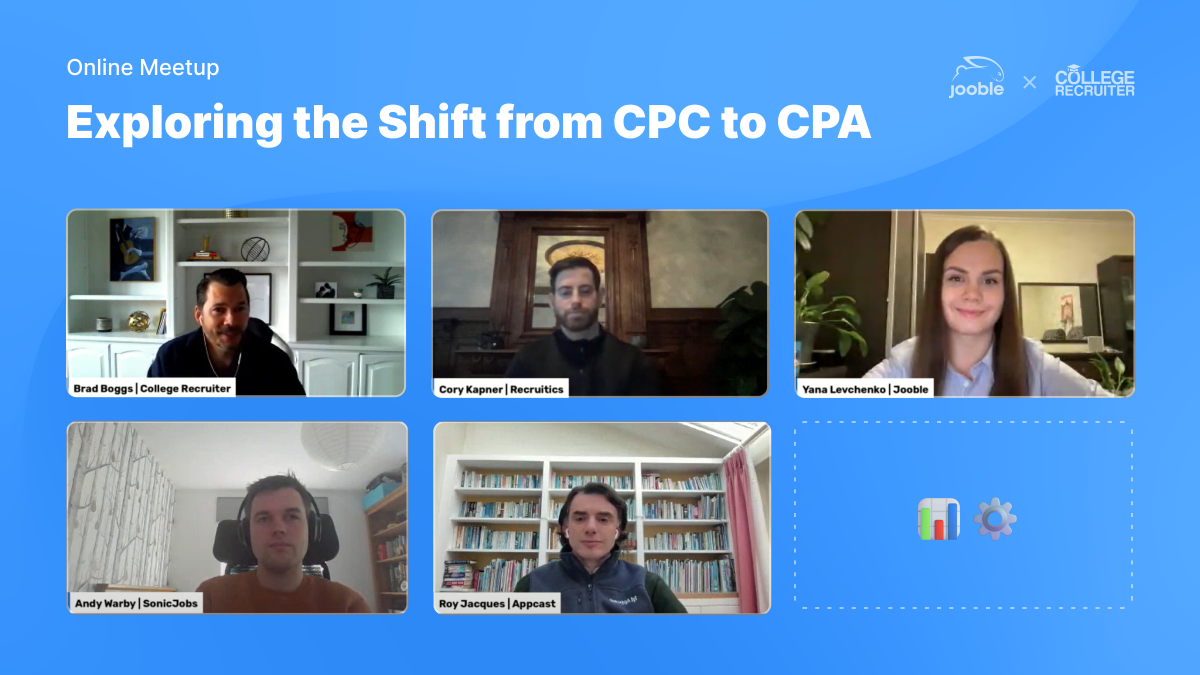
On 9th November, the virtual meetup “Exploring the Shift from CPC to CPA”, organised by College Recruiter and Jooble, was held. Participants discussed and shared insights on transitioning from traditional job advertising to more innovative models.
The meeting was attended by:
Jooble’s Tactics: Experience-Based Examples
Yana Levchenko, the Customer Success Executive B2B at Jooble, explained the models Jooble sticks to.
Jooble operates on a performance-based business model. In this domain, options like CPC, CPA, CPAS, and CPQA are abundant, each with unique strategies. However, according to Yana, the central theme revolves around performance and delivering final value to the customer.
“The shared features of these options contribute to enhanced profitability for advertisers and yield improved results in real applications. We are steadily progressing towards higher standards in this field. Remembering and further developing these aspects is imperative.”
Jooble refrains from labelling it as inherently good or bad when discussing the most traditional approach- a duration-based model. Its suitability depends on specific client profiles. Key features include fixed prices and predictability in advertiser budgeting. While spending can be controlled, understanding the ultimate goal is crucial.
In a pay-per-click scenario, understanding clients’ ultimate objectives becomes paramount. Few market players seek empty clicks; most are after tangible outcomes such as subscriptions, applicants, or initiated applications. This understanding guides Jooble’s campaign launches, exemplifying the essence of performance-based marketing.
Is a traditional model or CPC and CPA-based pricing more suitable?
Roy Jacques, Managing Director for the UK & EMEA at Appcast, observed that performance-based models generally work well for most companies and job types, but he doesn’t always recommend it:
“If you’ve got very small job volumes, you’re probably better with duration. You know, you’ve got five or six jobs. When performing, a setup process often requires pixels and ATS tracking. So if you’ve got no ATS, go and buy duration. If you’ve got senior roles and typically use job boards for advertising three or four senior roles, go and use duration.”
Roy added that for those working in a niche industry with niche job boards serving small communities, it’s probably better to choose duration in those instances:“However, on the other end of the scale, if you are hiring at volume, hiring at scale, hiring internationally, you know, hiring on an evergreen basis, you probably want to look at performance”.
CPA Model: What Really Matters
Cory Kapner, Vice President of Global Sales & Partnerships at Recruitics, responded to a question regarding the critical aspects of using a CPA model, both from the advertiser and job board perspectives.
“Quality is paramount, and everyone has their own interpretation of quality. Depending on ATS integrations, if job boards are employing click-to-insite, where applicants apply on the ATS, and you’re losing traffic, the interplay between quality and cost always comes into consideration.”
In summary, the underlying framework involves transparency, quality, and collaboration.
Andy Warby, Head of Performance Marketing at SonicJobs, pointed out the necessary changes for buying or selling on a CPA basis:
“I think Cory was bang on when he said transparency was one of the most important things because any buying relationship that moves to CPA becomes much more collaborative. After all, I have to provide you with the fairest CPA, and you have to provide me with high-quality candidates. It has to be an interchange. We need to discuss the fairness of that relationship because if I’m paying you $1 for an application, that will be a very different role than if I’m paying $250. We need to ensure that we’re being fair and transparent in pricing and agreeing with tracking and data sharing”.
Advantages and Disadvantages of Shifting to CPA
Both positive and negative aspects exist when transitioning from the conventional duration-based model to CPA.
Advantages:
Disdvantages: